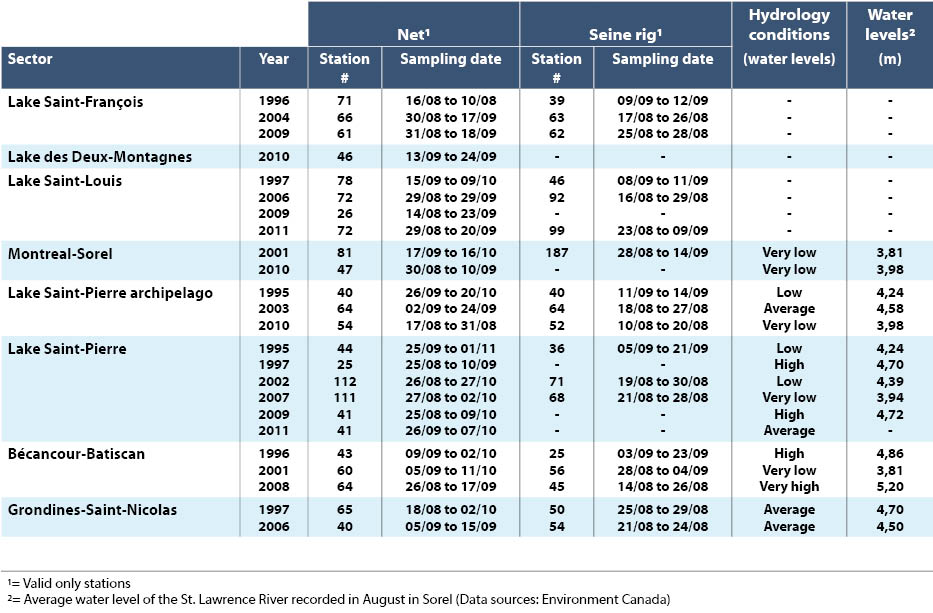Fish Monitoring Network - About
 The Fish Monitoring Network (FMN) is a St. Lawrence fish monitoring program operated by the Ministère des Forêts, de la Faune et des Parcs. FMN samples standardized and reproducible data upon fish populations in order to assess the health status of the St. Lawrence River freshwater sectors and its main tributaries (Figure 1). These official data were produced as part of the St. Lawrence 2011-2026 Action Plan. As the river is of such a large scale, it takes approximately six to seven years to inventory all sections between the Ontario border and the upper estuary. Three cycles of sampling were carried out between 1995 and 2011 (Table 1).
The Fish Monitoring Network (FMN) is a St. Lawrence fish monitoring program operated by the Ministère des Forêts, de la Faune et des Parcs. FMN samples standardized and reproducible data upon fish populations in order to assess the health status of the St. Lawrence River freshwater sectors and its main tributaries (Figure 1). These official data were produced as part of the St. Lawrence 2011-2026 Action Plan. As the river is of such a large scale, it takes approximately six to seven years to inventory all sections between the Ontario border and the upper estuary. Three cycles of sampling were carried out between 1995 and 2011 (Table 1).

Figure 1. Main sectors of the St. Lawrence River sampled through the fish monitoring network (FMN). Other areas were also sampled for exploratory purposes (e.g., Lake of Two Mountains, High Richelieu and the Missisquoi Bay).
These fundamental data serve a wide range of purposes and do so in giving sustenance to research and management decisions regarding the St. Lawrence ecosystem:
- Management of sportfishing and commercial fish stock exploitation;
- Monitoring of the status of fish communities and of their habitats;
- Monitoring of fish flesh contamination;
- Modelization of fish habitat;
- River flow regularisation impact assessment;
- Climate change impact assessment;
- Monitoring of striped bass reintroduction;
- Evaluation and status monitoring of rare or endangered species;
- Detecting and monitoring the spread of invasive species;
- Guidance of habitat restoration efforts;
- Fish health monitoring.

Table 1. Efforts deployed in the framework of the fish inventory network (FMN) in relation to the various sectors of the St. Lawrence River, on a yearly basis. Hydrological conditions during sampling are also presented for informational purposes.
The initiative of the fish monitoring network (FMN) generates many benefits both from a scientific and from a socioeconomic standpoint, as well as being influential on the international forefront. The knowledge gained from sampling activities has already enabled the production of several management plans, research reports, scientific papers and major oral communications. It also serves in regard to impact studies, legal expertise (fish habitat) and for wildlife notices (legal permits, consultations, restoration projects, etc.) in account of the regions bordering the St. Lawrence River.

Partners and Teams
Partners
- St. Lawrence Action Plan
- Ministère du Développement durable, de l’Environnement et de la Lutte contre les changements climatiques
- Environment Canada
- Hydro-Québec
Achieving FMN and FMNLV is, among others, made possible by the tariff revision of hunting licenses, fishing and trapping.
Teams
Faune Québec
Marc Mingelbier, Biologist
Yves Paradis, Biologist
Geneviève Richard, Technician
Denis Deschamps, Technician

Estrie-Montréal-Montérégie and Laval-Lanaudière-Laurentides Branch
Longueuil office
Pierre Dumont, Biologist
Nathalie Vachon, Biologist
Daniel Hatin, Biologist
Jean Leclerc, Technician
Sylvain Desloges, Technician
Huguette Massé, Technician
Florent Archambault, Technician
Mélissa Lamoureux, Technician
Guillaume Lemieux, Technician
Repentigny office
Chantal Côté, Biologist
Virginie Boivin, Technician
Catherine Greaves, Technician
Hugo Mercille, Technician
Mauricie and du Centre-du-Québec Branch
Philippe Brodeur, Biologist
Rémi Bacon, Technician
Nicolas Auclair, Technician
Ministère du Développement durable, de l’Environnement et de la Lutte contre les changements climatiques
Denis Laliberté, Chemist
Jean-Philippe Baillargeon, Technician

Contact and Links
Contact
Yves Paradis
Direction de la faune aquatique
Ministère des Forêts, de la Faune et des Parcs
880, Chemin Ste-Foy, 2nd Floor
Québec (Québec) G1S 4X4
Telephone: 418.627.8694 ext 7424
Email: Yves.Paradis@mffp.gouv.qc.ca
Links and Medias
- St. Lawrence Action Plan
- Guide de consommation du poisson de pêche sportive en eau douce [Only in French]
- Portes ouvertes virtuelles MRNF – L’inventaire piscicole [Only in French]
- Pêche sportive au Québec, principales règles en vigueur [Only in French]


